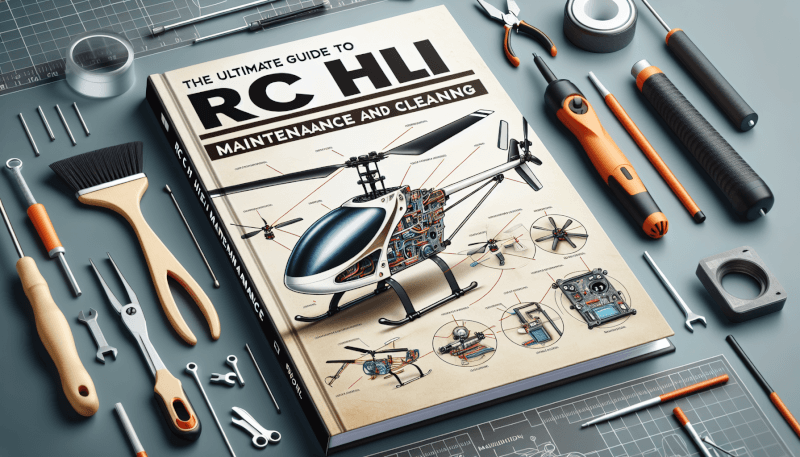Maintaining and cleaning your RC helicopter is essential to keeping it in top-notch condition and ensuring optimal performance. In this comprehensive guide, you will discover the best practices and techniques for maintaining and cleaning your RC heli. From the basics of cleaning and inspecting your helicopter to advanced maintenance tips, this ultimate guide will provide you with all the knowledge and strategies you need to keep your RC heli in tip-top shape. Whether you are a beginner or an experienced pilot, this guide is your go-to resource for all things RC heli maintenance and cleaning. So grab your cleaning supplies and get ready to prolong the life of your favorite flying machine.

Why Maintenance and Cleaning is Important for RC Helis
Maintaining and cleaning your RC heli is crucial to ensure its optimal performance and longevity. Regular maintenance and cleaning not only prevent potential issues but also improve overall safety and reliability. In this comprehensive guide, we will explore the importance of maintenance and cleaning and provide you with the necessary tools and techniques to keep your RC heli in top shape. So let’s dive in!
Preventative Maintenance
Preventative maintenance is all about taking proactive steps to prevent potential problems before they occur. By regularly inspecting and maintaining your RC heli, you can identify any issues early on and address them promptly. This approach minimizes the risk of major breakdowns and ensures that your heli remains in optimal condition.
Performance Optimization
Regular maintenance and cleaning also play a vital role in optimizing the performance of your RC heli. By keeping all the components clean and in good working order, you can achieve smoother flights, better maneuverability, and improved overall performance. Additionally, regular maintenance allows you to fine-tune and adjust different aspects of your heli to suit your flying style and preferences.
Prolonging the Lifespan
Proper maintenance and cleaning can significantly prolong the lifespan of your RC heli. By regularly inspecting and addressing any wear and tear, you can prevent small issues from escalating into major problems. Additionally, by keeping your heli clean and well-maintained, you can minimize the accumulation of dirt, dust, and debris, which can cause damage if left unchecked.
Safety and Reliability
Above all, maintenance and cleaning are essential for ensuring the safety and reliability of your RC heli. Regular inspections allow you to identify potential safety hazards and take appropriate measures to address them. By keeping all the components in good condition, you can have peace of mind knowing that your heli is reliable and safe to operate.
Tools and Equipment for RC Heli Maintenance and Cleaning
To effectively maintain and clean your RC heli, you’ll need the right tools and equipment. Here are the essential items you should have in your toolbox:
Basic Tool Kit
A basic tool kit for RC heli maintenance should include a variety of tools such as screwdrivers (both flathead and Phillips), pliers, hex drivers, socket wrenches, and wire cutters. These tools will allow you to perform basic maintenance tasks and make any necessary adjustments to your heli.
Cleaning Supplies
To keep your RC heli clean, you’ll need a few cleaning supplies. These may include soft brushes for removing dust and debris, compressed air cans for blowing away stubborn dirt, cotton swabs for cleaning hard-to-reach areas, and isopropyl alcohol for disinfecting and degreasing.
Lubricants and Adhesives
Lubricants and adhesives are essential for maintaining proper functionality and preventing wear and tear. You’ll need to have a suitable lubricant for bearings, gears, and other moving parts. Additionally, adhesives such as thread lockers and CA glue may be necessary for securing loose components or repairing broken parts.
Pre-Flight Maintenance and Inspection
Before each flight, it’s important to perform a thorough pre-flight maintenance and inspection routine. This ensures that your RC heli is in optimal condition and ready for a safe flight. Here are the key areas to check:
Checking the Battery
Start by checking the condition of your heli’s battery. Inspect the battery for any signs of damage or swelling. Ensure that the connectors are clean and securely attached. If you notice any issues, it’s best to replace the battery to avoid any potential safety hazards.
Inspecting the Blades
Next, carefully inspect the blades of your RC heli. Look for any cracks, chips, or other signs of damage. Ensure that the blades are securely fastened and balanced. If you notice any issues, replace the damaged blades to maintain proper flight stability.
Examining the Gear Train
Inspect the gear train of your heli, including the main gear, pinion gear, and tail gear. Look for any signs of wear, misalignment, or damage. Ensure that the gears are well-lubricated and rotate smoothly. If you notice any issues, make any necessary adjustments or replace the damaged gears.
Verifying the Electronics
Check all the electronics components of your RC heli, including the receiver, transmitter, and servos. Ensure that all the connections are secure and free from corrosion. Test the functionality of the controls and verify that they respond accurately to the transmitter inputs.
Assessing the Frame and Connectors
Inspect the frame and connectors of your heli for any signs of cracks, damage, or loose connections. Check the landing skids, landing gear, and any other structural components. Ensure that everything is securely fastened and in good condition. If you notice any issues, tighten loose connections or replace damaged parts.
Post-Flight Cleaning and Maintenance
After each flight, it’s important to clean and maintain your RC heli to ensure its longevity and optimal performance. Here are the key steps to follow:
Removing Dust and Debris
Using a soft brush, gently remove any dust and debris from your RC heli. Pay attention to hard-to-reach areas such as the rotor head, tail boom, and under the canopy. Be careful not to apply excessive force or damage any delicate components.
Cleaning the Rotor Head
To clean the rotor head, use a cotton swab soaked in isopropyl alcohol to wipe away any dirt or residue. Pay close attention to the bearings and ensure that they are clean and well-lubricated. Remove any excess lubricant to prevent attracting more dirt in the future.
Wiping Down the Body
Using a microfiber cloth or a soft damp cloth, wipe down the body of your RC heli to remove any dirt or fingerprints. Be cautious when cleaning any decals or delicate stickers as excessive rubbing may damage them. Allow the body to air dry before storing or using the heli again.
Cleaning the Landing Gear
Inspect and clean the landing gear of your RC heli. Remove any dirt, grass, or debris that may have accumulated during the flight. Ensure that the landing gear is securely fastened and in good condition. If needed, lubricate any moving parts to maintain smooth operation.
Checking for Loose Parts
Finally, perform a quick check for any loose parts or components. Gently shake your RC heli and listen for any rattling or unusual sounds. Inspect all screws, nuts, and connectors to ensure they are tight and properly secured. If you notice anything loose, tighten the connections or replace any damaged parts.

Long-Term Storage and Maintenance
If you plan to store your RC heli for an extended period, proper long-term storage and maintenance are essential to preserve its condition. Here are some steps to follow:
Discharging and Storing the Battery
Before storing your RC heli, make sure to discharge the battery to a safe storage voltage. Refer to the manufacturer’s guidelines for the recommended storage voltage. Store the battery in a cool and dry place, away from direct sunlight or extreme temperatures.
Protecting the Blades
To protect the blades during storage, consider using blade covers or blade holders. These accessories prevent the blades from getting damaged or bent while your heli is not in use. Store the heli in a padded case or bag to further protect it from dust and potential impacts.
Applying Lubrication and Moisture Barriers
Before storing your RC heli, apply a small amount of lubricant to the main bearings, tail rotor bearings, and any other moving parts. This prevents rust and ensures smoother operation when you take your heli out of storage. Additionally, consider using moisture-absorbing packets or containers to keep the humidity levels in check.
Inspecting and Maintaining the Frame
Regularly inspect the frame of your RC heli even during storage. Look for any signs of cracks, damage, or deterioration. If you notice any issues, take appropriate action to repair or replace the damaged parts. Additionally, periodically apply a protective coating or wax to the frame to prevent corrosion.
Troubleshooting and Common Issues
Even with proper maintenance and care, RC helis can experience issues from time to time. Here are some common problems you may encounter and how to address them:
Diagnosing Electrical Problems
If your RC heli is experiencing electrical issues, such as random servo movements or loss of signal, start by checking the batteries and connectors. Ensure that the batteries are charged and properly connected. If the problem persists, inspect the wiring and connections for any loose or damaged components.
Addressing Mechanical Issues
Mechanical issues can manifest as vibrations, unusual noises, or jerky movements. Start by inspecting the gears, bearings, and other moving parts for any signs of wear or damage. Check for misalignment or loose connections. If you identify any worn-out or damaged components, replace them promptly.
Dealing with Crashes and Impact Damage
Crashes and impact damage are unfortunate but common occurrences in RC heli flying. After a crash, carefully inspect your heli for any visible damage. Check the blades, frame, and all other components for signs of cracks, bends, or other structural issues. Address any damage by replacing or repairing the affected parts.

Upgrading and Customizing Your RC Heli
For enthusiasts looking to take their RC heli to the next level, upgrading and customizing can enhance performance and provide a personalized experience. Here are the key steps involved:
Choosing Upgrades and Modifications
Research and evaluate the different upgrades and modifications available for your specific RC heli model. Consider your flying style, preferences, and the desired improvements. Consult online forums, communities, and expert opinions to gather information and make informed decisions.
Installation and Setup
Once you have chosen the upgrades and modifications, carefully follow the manufacturer’s instructions for installation. Take your time and ensure that each component is properly installed, tightened, and aligned. Follow any specific setup instructions to optimize the performance of the upgraded parts.
Testing and Tuning the Changes
After the installation, thoroughly test your RC heli to ensure that everything is functioning as expected. Take gradual steps and make any necessary adjustments or fine-tuning to optimize the performance. Monitor the flight characteristics and make note of any improvements or areas that require further adjustments.
Expert Tips and Techniques
To further enhance your RC heli maintenance and cleaning, here are some expert tips and techniques:
Routine Maintenance Schedule
Establish a routine maintenance schedule based on your flying frequency and the manufacturer’s recommendations. Regularly inspect and maintain your heli, even if you haven’t been flying frequently. This allows you to catch any potential issues early on and maintain the best possible performance.
Proper Cleaning Techniques
When cleaning your RC heli, be gentle and avoid applying excessive force or pressure. Use soft brushes, cotton swabs, and microfiber cloths to prevent scratching or damaging delicate components. Consider using compressed air cans for blowing away dirt and debris.
Understanding the Manual and Specifications
Always refer to the manufacturer’s manual and specifications for your RC heli. Familiarize yourself with the recommended maintenance procedures and guidelines. Understand the limitations of your heli and ensure that any upgrades or modifications you choose are compatible and within the specified parameters.

Safety Precautions
When working with RC helis, it’s important to prioritize safety. Here are some safety precautions to keep in mind:
Battery Safety
Always handle and charge your RC heli batteries with caution. Follow the manufacturer’s recommendations for charging and storage procedures. Avoid exposing the batteries to extreme temperatures or leaving them unattended during charging. Dispose of damaged or swollen batteries safely.
Safety Gear
Wear appropriate safety gear, such as goggles or eye protection, when working on or flying your RC heli. This protects your eyes from any potential debris or accidents. Additionally, consider wearing gloves to safeguard your hands from sharp edges or potentially hot components.
Working in a Controlled Environment
When flying or performing maintenance on your RC heli, choose a controlled environment. Ensure that you have enough space and avoid crowded or heavily populated areas. Maintain a safe distance from people, pets, and objects that could potentially interfere with your flight.
Conclusion
Maintenance and cleaning are essential aspects of owning and operating an RC heli. By following the guidelines and techniques outlined in this ultimate guide, you can ensure the proper care and longevity of your RC heli. Remember, preventative maintenance, regular cleaning, and addressing any issues promptly will contribute to a safer, more reliable, and enjoyable flying experience. So, keep your heli in top shape and happy flying!



